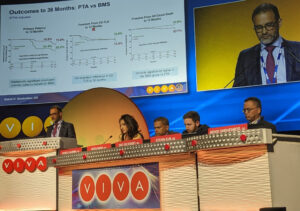
A patient-level, propensity-adjusted comparison of three-year results from a quartet of prospective, multicentre trials support the primary use of drug-coated balloons (DCBs) versus bare metal stents (BMS) in moderately complex femoropopliteal lesions, new data show.
Lead researcher Mehdi Shishehbor (Harrington Heart & Vascular Institute, Cleveland, USA) revealed adjusted Kaplan-Meier estimates showing a 12-month primary patency of 90.4% for DCB vs. 80.9% for BMS (p=0.007); freedom from 36-month clinically driven target lesion revascularisation of 85.6% for DCB vs. 73.7% for BMS (p=0.001); and cumulative 36-month major adverse events of 25.3% for DCB vs. 38.8% for BMS (p<0.001).
Shishehbor delivered the data during the 2022 Vascular Interventional Advances (VIVA) meeting (31 October–3 November, Las Vegas, USA), reporting “superior effectiveness” in favour of DCB use and no differences in mortality, amputation, or thrombosis. The results were simultaneously published in the Journal of the American College of Cardiology (JACC).
Patient-level data were pooled from the DCB arms of the IN.PACT SFA I/II and IN.PACT SFA Japan randomised controlled trials, and the prospective, multicenter, single-arm Complete SE and DURABILITY II BMS studies. DCBs and BMSs were compared using the inverse probability of treatment weight method with weighted log-rank p values.
“The question for us was comparing the safety and efficacy of DCB versus bare metal stents in patients with femoropopliteal disease who have Rutherford class 2–4,” Shishehbor told VIVA 2022.
A total of 771 patients (288 DCB; 483 BMS) were included in the primary analysis. Demographic, baseline lesion and procedural characteristics were matched between treatment groups after adjustment.
“In this prospective, patient-level pooled analysis with advanced statistical methods comparing the safety and efficacy of DCB versus bare metal stent in prospectively conducted studies with core lab adjudication, we showed that DCBs had a superior primary patency at 12 months on duplex ultrasound and superior freedom from clinically driven [target lesion revascularisation] at 36 months compared to BMS,” Shishehbor concluded at VIVA. “There were no significant differences at 36 months for all-cause mortality amongst the three arms. This analysis supports the use of DCB vs. bare metal stenting in moderately complex femoropopliteal lesions, which are amenable to both treatments.”













